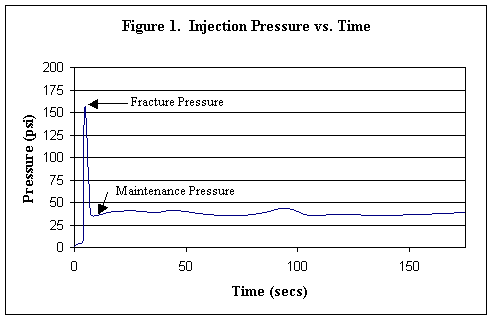Hydraulic Fracturing
Hydraulic fracturing is used to improve the permeability of the subsurface. Hydraulic fracturing involves injecting a liquid or slurry solution at a pressure that exceeds the combined lithostatic pressure and cohesive strength of the formation. The lithostatic pressure is essentially equivalent to the weight of the soil column above the injection point. The cohesive strength is a measure of how well the soil particles have adhered to one another. For example, clays have significantly greater cohesive strength.
the permeability of the subsurface. Hydraulic fracturing involves injecting a liquid or slurry solution at a pressure that exceeds the combined lithostatic pressure and cohesive strength of the formation. The lithostatic pressure is essentially equivalent to the weight of the soil column above the injection point. The cohesive strength is a measure of how well the soil particles have adhered to one another. For example, clays have significantly greater cohesive strength.
Redox Tech uses a Geoprobe® and a mobile injection trailer to complete hydraulic fracturing. The Geoprobe® rod is driven to depth, and then the outer casing is retracted to expose a proprietary injection nozzle. The fluid is pumped into the formation at a rate that exceeds the ability of the formation to accept the fluid. As a result, the pressure continues to rise until fractures are created. The injection pressure drops dramatically at the onset of fracturing (see Figure 1). Fracturing pressures for unconsolidated sediments at depths less than 50 feet can range from 80 psi to 250 psi. After fracturing occurs, the fluid must be continued to be injected to keep the fractures open. The pressure to keep the fractures open is called maintenance pressure. The maintenance pressure is about 10% to 50% of the fracture pressure.
With hydraulic fracturing, the injection rate can easily be increased up to one order of magnitude. Also, the radius of influence that is obtained can be increased by a factor of two to three times. This reduces the time required and results in significant cost savings over conventional injection technology.
Pneumatic Fracturing
Pneumatic fracturing involves injection of gas at to increase the permeability of a formation. The gas is injected at a rate that significantly exceeds the formations ability to accept the gas. Therefore, the pressure builds until the lithostatic pressure and cohesive strength is exceeded. This fractures the formation allowing remediation amendments to permeate the formation for in situ remediation.
Redox Tech’s Pneumatic Fracturing Group consists of the former principal engineer, senior project and field managers of former ARS Technologies, which advanced and commercialized the technology in the environmental industry in the late 1990’s based on NJIT’s patent. Collectively, our technical staff has the most pneumatic fracturing experience in the industry. The following are several New Jersey projects managed or field-supervised by our current staff:
• Former Fortune 100 industrial facility – Highland Park, NJ. Pneumatic Fracturing in weathered Brunswick shale in the vadose and saturated zones as part of a large SVE / Groundwater treatment system. Additional application of Pneumatic Fracturing to emplace ZVI to address a small portion of the site with lingering residual TCE concentrations prior to achieving closure of the site.
• Confidential Development Property – River Edge, NJ. Pneumatic Fracturing in Brunswick Shale and injection of EHC via 25 injection boreholes emplacing more than 175,000 lbs of EHC.
• Former Industrial Site – Piscataway. Pneumatic Fracturing and ZVI injection at depths approaching 130 feet bgs and pressures to 600 psi. Targeted 10-foot injection intervals with goal of 1,500 pounds of ZVI per point. Mike Clark, who is now with Redox Tech, was the field lead.
Redox Tech continue to invest and improve the process both in terms of custom-building state-of-the-art equipment as well as developing more effective application approaches. In conjunction with our drilling expertise, we are able to design the most effective combined drilling and fracturing approach to emplace the select treatment amendments.
Within the past year, RT has performed Pneumatic Fracturing injection at the following sites:
· DOD Facility – Former Atlas Missile site – Laramie County, WY. Conducting pneumatic fracturing at depths approaching 150 feet in fractured sandstone formation to facilitate injection of ZVI slurry and oxidant solution at multiple plume areas.
· Active Commercial Property – Newcastle, WA. Pneumatic Fracturing was performed in 11 boreholes in a clayey formation to facilitate the injection of a carbon substrate, Dhc culture and zero-valent iron to addressing a chlorinated solvent source area.
· Federal Facility – Silver Spring, MD. Pneumatic Fracturing was conducted in 12 boreholes advanced by sonic drilling within a saprolite formation in conjunction with injection of zero-valent iron.
· Former Industrial Facility – Willits, CA. Pneumatic Fracturing and proppant injection was conducted in 9 boreholes in a clayey formation to increase the soil bulk permeability to enhance a soil vapor extraction remediation treatment system.
· DOD Facility – Tracy, CA. Conducted Pneumatic Fracturing to increase unsaturated zone clayey soil permeability as part of a full-scale SVE treatment system installation.